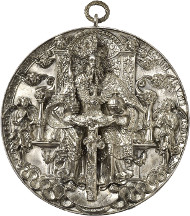Trinity Medal
Hans Reinhart the Elder ranges amongst the most extraordinary artists of the 16th century. Off the known centers of the German medal production – Nuremberg and Augsburg –, he created highly masterful medals bearing the portraits of his famous contemporaries and with religious-biblical references during a comparatively short period of time (1535/1545). Actually, not much is known about this artist’s life:
He was born in Dresden (or Torgau) probably around 1510 and was citizen of Leipzig in 1539, as testified by written evidence. There, he was denied membership in the guild of gold- and silversmiths at first, because he was considered to be just a ‘carpenter’ or a ‘groschen founder’. Thus, Hans Reinhart completed a five year mature apprenticeship as a gold smith.
Until his death in 1581, he created at least 26 works that bear his signature. Another 30 medals can be attributed to him or his workshop due to stylistic reasons. In addition, Reinhart worked as a decorative wood carver in the 1530s. It seems that he mastered both the art of wood carving as well as processing gold. His works, most of which he signed with his monogram ‘HR’, often follow the paintings of painter and printmaker Lucas Cranach the Elder (1472-1553).
On March 13, 2014, in auction 247 of the Osnabrück auction house, one of the most beautiful Renaissance medals will be offered for sale. The gorgeous cast silver medal by Hans Reinhart is estimated at 40,000 euros.
The Trinity Medal from 1544 is not only the magnum opus of the Renaissance artist but also concludes his work as creator of medals that most likely ended with finally being granted entry into the Leipzig guild of goldsmiths in 1547.
Lucas Cranach the Younger, Detail of Maurice, Elector of Saxony and his wife Agnes, 1559.
This extraordinary showpiece refers to the efforts prior to the Schmalkaldic War (1546-1547), particularly of Duke Maurice, to reach an agreement between Catholics and Protestants which is why the work is considered to be commissioned by Maurice who converted to Protestantism in 1539. At any rate, both depiction and text are theologically sophisticated.
The large tablet, held by two flanking angels, quotes extracts from the Athanasian Creed. Apart from the Apostolian and the Nicene-Constantinopolitan Creed, the Athanasian Creed is one of three important statements of belief of the Catholic Church. It differs from the other two concerning some controversial details. It doesn’t mention the ‘communion of saints’ or the ‘one, holy, catholic and apostolic church’. As such, the Athanasian Creed was suited to become the point of departure for a unification of the different statements of belief.
Thus, Hans Reinhart used some parts of the Athanasian Creed for the medals’ reverse which can be translated as follows: ‘And the catholic faith is this: That we worship one God in Trinity, and Trinity in Unity; Neither confounding the Persons; nor dividing the Essence. For there is one Person of the Father; another of the Son; and another of the Holy Ghost. But the Godhead of the Father, of the Son, and of the Holy Ghost, is all one; the Glory equal, the Majesty coeternal.’ That passage is followed by a hymn of praise of that trinity that is probably related to the antiphon: ‘O most Holy Trinity’ : ‘O most Holy Trinity, O most holy Undivided Unity. You created us, Father Eternal. With You, we are saved, You most Holy Love. We praise You, Almighty. We sing to You. Praise and honor be to You.’
The models of the obverse derived from graphic art and architectural sculpture of the Saxon region of the early 16th century: both a woodblock print by Lucas Cranach the Elder (1472-1553) from Wittenberg from c. 1512 and the ‘Schöne Tür’ (Beautiful Door) of St. Anne’s Church in Annaberg and the portal of the Chemnitz Castle Church by Hans Witten (around 1470/80-after 1522) exhibit the subject of the obverse in a slightly different form. Hans Reinhart, being a woodcarver, is likely to have known these works.
Art historians since the 19th century have been referring to the iconographical type on the obverse as Mercy Seat. It presents God the Father enthroned with scepter and orb, holding Christ on the crucifix before him who is surmounted by a dove representing the Holy Spirit. The scene is surrounded by angels and cherubs. The innovative technique of the artist is remarkable in that he made the parts of the medal that couldn’t be cast, separately and soldered them onto the work of art in a second step. This is how the fine locks of the beard, for example, were made.
The popularity of the Trinity Medal is evidenced by the numerous imitations and recasts. The specimen offered at Künker, bearing the year 1544, belongs to the first edition. There are other pieces with the date 1556, 1561, 1566, 1568 and 1574. Hans Reinhart died in 1581 – later recasts were most probably made in the workshop of his eldest son, Hans Reinhart the Younger (died in 1622), or were produced at the initiative of private founders. Many of the known specimens differ slightly in their execution.
The desire for an amicable union of the confessions evidently continued to be a central topic in the generations that succeeded Luther.
You can read an auction preview of this auction here.
And this is the link to go directly to the sale.











